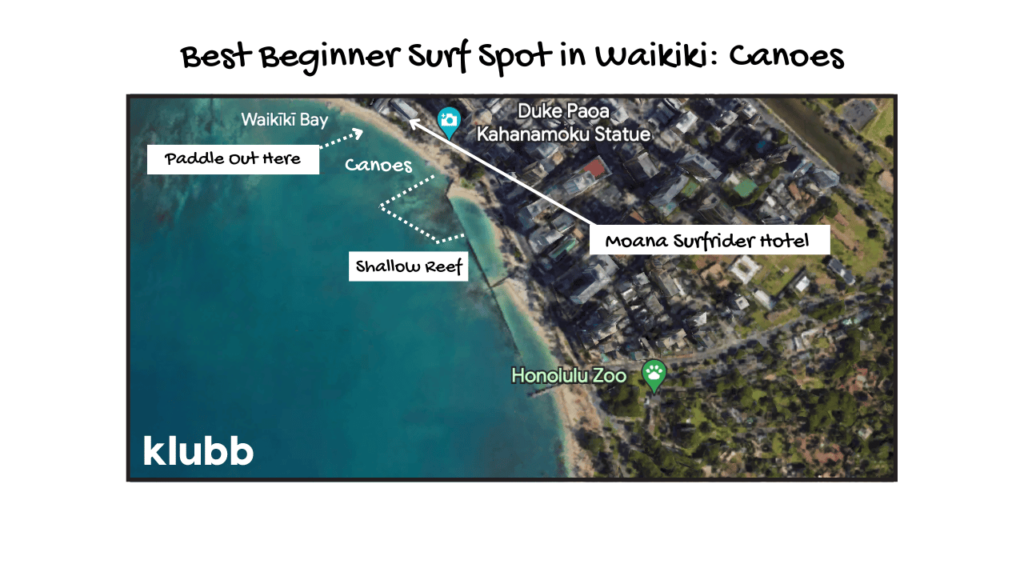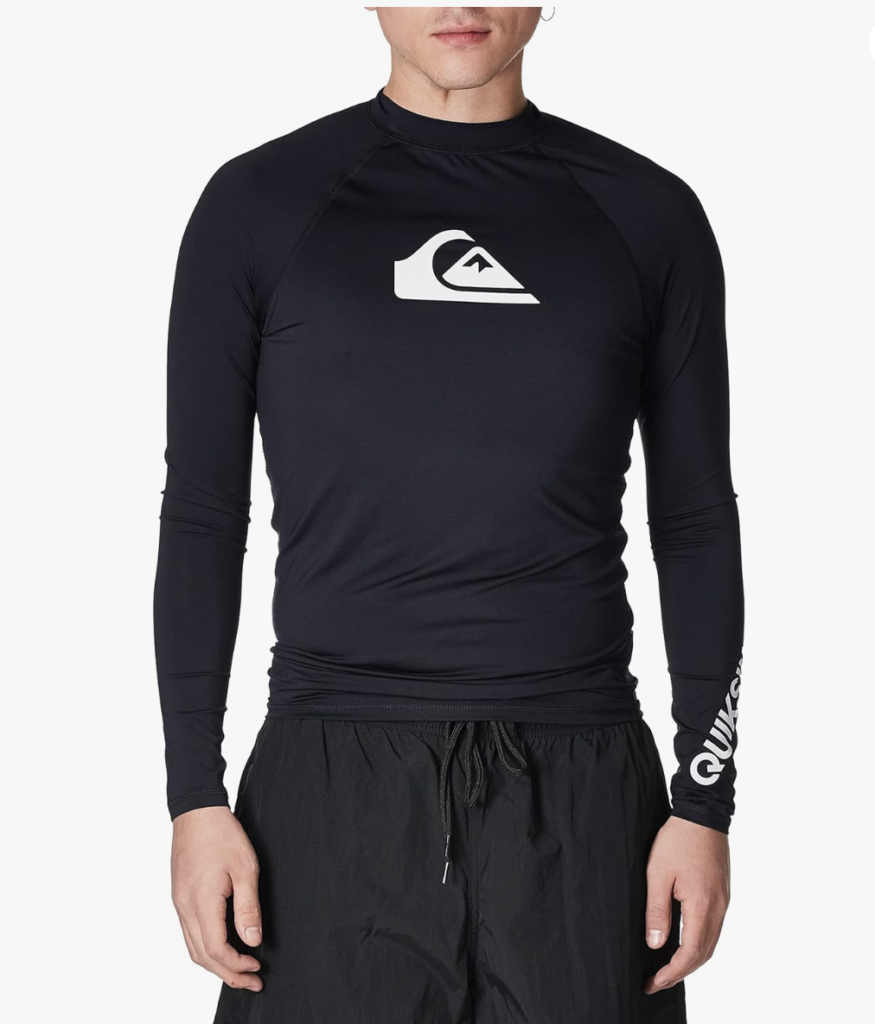Top 6 Best Waikiki Surf Spots for Beginners
Surfing for your first time in Waikiki is an experience you will never forget. Waikiki is perfect for beginners who are trying surfing for the first time.

Surfing for your first time in Waikiki is an experience you will never forget. Waikiki is perfect for beginners who are trying surfing for the first time.

Surfing in Waikiki is the best way to spend your day. Warm water, playful waves, and endless Aloha make it the best spot for beginners. Having lived in Waikiki for almost a decade, I’ve had close to a thousand days surfing the different surf breaks. Through this first had experience and in-depth research of oceanography, I’ve put together a list of the best Waikiki surf spots for beginners.
As a beginner surfer, you have plenty of options for finding a fun break that will make your first time surfing a great experience. If you are interested in Standup Paddle Boarding in Waikiki, most board rental services rent SUP boards as well.

What makes surfing in Waikiki so great for beginners is the consistent, slow rolling waves that are close to shore. The waves closest to shore have already lost most of their energy because of the multiple reefs extending outwards to the ocean. On very large days, the waves break on the furthest reef out, which is a half mile off shore. It is the outer reef that helps to absorb the swell energy on smaller swells and make the best Waikiki surf spots for beginners. However, not all waves are equal when it comes to surfing Waikiki.
The ocean floor plays a big part in what makes a wave suitable for beginners. Some reefs in Waikiki have a more abrupt plateau which causes the wave to “stand up” much faster. This means that the face of the wave has a steeper angle to it and makes getting up much more difficult for first time surfers. You can tell when the wave stands up because it starts to fall forward on itself quickly after, creating white water.
Reefs with a flatter ocean surface leading up disperse the energy of the swell more before they become a surf able wave. This is important because these waves have a much flatter angle. Having a flatter angle allows for a much easier entry onto the wave. The large foam surfboards that you will be learning on are built for this kind of wave.

The accessibility to the hotels, dozens of board rental services, and the multiple surf breaks makes Waikiki an excellent place for beginner and first time surfers. Having year round surf is another reason why Waikiki is great for surfing. Any day of the year (for the most part), you can find small waves to have fun surfing.
Surf spots like Canoes are mostly crumbling whitewater. This is perfect for learning how to standup for the first time. There is enough energy from the whitewater to give you the momentum to standup. And, without having a steep wave face to deal with, the whitewater makes for endless fun.

In addition to the great beginner waves, Waikiki beach has multiple lifeguard towers and some of the best lifeguards in the world on duty. Take advantage of the knowledge these waterman have before paddling out. They will be happy to share their intimate understanding of the ocean conditions with you.
If it is your very first time surfing, you should take a lesson. Chances are your instructor will take you to Canoes – our #1 best Waikiki surf spot for beginners. This is the most forgiving wave in Waikiki. Next to Canoes is Sandbar. Another very forgiving wave that has a more sand covered bottom.
For beginners who are comfortable standing up on their own, and have good paddle strength, breaks like Pops and Publics will be a fun additional challenge. And, for those who are knocking at the door of being intermediate, try surfing at Queens. Queens has a steeper wave face than canoes and makes for a more critical take off.
Surf spots are ranked from the easiest wave (#1) for beginners to more advance waves.
Known for its playful waves, Canoes is the easiest surf sport in Waikiki. The long reef essentially causes the wave to close out all at once. Closing out means that the wave topples over on itself across the entire face of the wave. Once the wave closes out, you are left with whitewater that continues to move steadily towards the shore. It is this long wall of whitewater that is perfect for first time surfers.

Hazards: Watch out for surfing canoes loaded with tourists. These canoes are big, heavy, and likely don’t see you. It is up to you to keep away from these big boats. The canoes typically go in a straight line towards shore so as long as you are far enough away from them you will be safe.
Similar to Canoes, Sandbar offers mellow whitewater that is easy to learn to surf on. Surfing at Sandbar is less consistent than Canoes but usually has a few less people. Because the wave is less consistent you may have to move around a bit more to put yourself in the right spot to catch a wave.

Hazards: The sailing catamarans go in and out through the sandbar. A deckhand will blow a conch shell as they come in so keep your ears open for this noise.
While the bottom is mostly sand, there are random patches of sharp coral. Be careful jumping off your board as the coral can cut your feet.
The inside of publics breaks consistently along a reef. This makes for very predictable waves and a fun surfing experience. Publics has more “shape” than Canoes and Sandbar. Shape refers to the way in which the wave breaks (i.e. whitewater topples over). Facing the ocean, you will see the wave break from left to right. This wave shape is called a “left”. The surf takes off at edge of where the whitewater starts and rides the face of the wave left along the steeper wave face that is just about the topple over.
Local Tip: After surfing Publics, take a short walk up Monsarrate Ave to Diamond Head Grill. The plate lunches at Diamond Head Grill are the best on the island. If you go early, grab a blueberry and cream cheese scone as well, another local favorite.

Hazards: The reef at publics gets very shallow at low tide. Be careful getting in and out of the water. There is also sea urchins or “Wana” in Hawaiian, that scatter the reef at Publics. Jumping off your board feet first could lead to an unpleasant urchin spine in your foot.
It is a long paddle to get to Pops surf spot in Waikiki. This long paddle weeds out some of the first timers and gives you the opportunity for more space and pushing your abilities.

Hazards: Being further out in the water means you are much more exposed to the trade-winds wind line that blows East to West. If you are too far out, this wind will push you West towards more advanced waves, shallow reefs, and even further from shore. When surfing further out, you need to make sure you have enough paddle power to get back in. Be mindful of your limits.

Reserved for the locals, Queens should not be surfed on one of the large foam rental boards. Because of the shallow reef, the wave at Queens stands up quickly and will cause anyone on a big board to go nose first into the shallow water.

Beginners who are on mid sized boards or can handle a fiberglass longboard well will love surfing Queens. While Queens is ranked #5 because it is more challenging than the other waves, it is really the best break in Waikiki. When it comes to the choosing best Waikiki surf spots for beginners, find a wave that looks smaller than what you think you are comfortable with. Once out in the water, wave heights will look much bigger. Start somewhere easy and you can always paddle over to somewhere more advanced.
When you are feeling extra confident in your surfing, Paradise is one of the more challenging surfing breaks in Waikiki. The paddle is extremely log and you will feel very isolated when sitting in the lineup. Paradise breaks off a shallow reef that is about a quarter mile off shore. The coral is very sharp and there are jagged pipes that jet up from the reef.

Beginner surfers who are comfortable at Pops can make the paddle to Paradise for a more challenging wave. If you are looking for an advanced wave to surf in Waikiki, check out Kaisers surf spot.
If you are new to surfing, be prepared for a great work out and an amazing nights sleep! Before you paddle out, there is a lot you should do to prepare. In fact, preparing for surfing starts three days before you even get to the beach. This is because of the time it takes – three days – to hydrate your body effectively.
For the 3 Days Prior to surfing for the first time you need to hydrate your body. The easiest formula for calculating how much water you should drink is to take your body weight and divide it in half. That is how many ounces per day you should drink.
However, when preparing for a sport that is as exerting as surfing, it is important that you also take electrolytes. Simply drinking water will flush your system. By adding electrolytes you are maximizing your hydration. I typically switch off between water and water+electrolytes. Below is a sample schedule.
The day that you are going to be surfing, be sure to drink a water+electrolytes prior to getting in the water. In addition to hydrating, you should wear ample reef safe sunscreen. Also, take off any jewelry or necklaces before getting into the water. Even small days can get disorienting in the white water and jewelry can get lost. Checkout our post on the best breakfast spots in Waikiki for the perfect pre-surf meal.
Post surfing, keep your hydrating schedule going. Your body will been drained and it is important that you replenish right away. By staying hydrated you will be able to explore more of the Best Waikiki Surf Spots for Beginners the next day.
The soft top longboards that are used for surf lessons are great for learning on but can give you a bad rash if you’re not prepared. A long sleeve rash guard is a must when your are learning to surf. Most rash guards are UPF rates as well giving you added sun protection.







